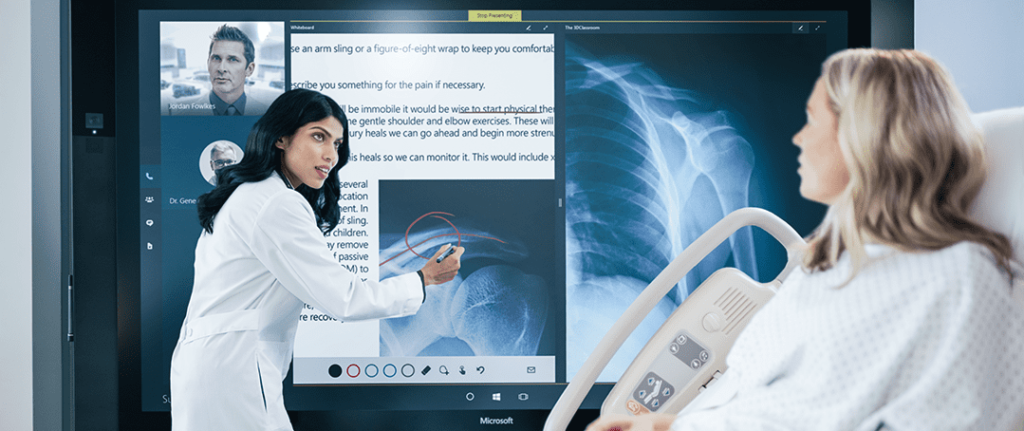
Driving Digital Transformation in Health to Achieve the Triple-Aim
Today, we are excited to participate in the 4th annual US News Healthcare of Tomorrow conference, bringing together leaders from across the health industry and care continuum to share their digital transformation journeys. We believe that the current mobile-first and trusted cloud-first technology innovation waves can empower healthcare leaders to digitally transform care, health promotion, and disease prevention in ways we’ve never before imagined to achieve the triple aim – better health, a better care experience, both at a lower cost per capita.
When we say mobile-first, it’s about mobility now being the mobility of the human experience across devices and places, not just a mobile device. When we say trusted cloud-first, it means that computing power is no longer confined to a device but rather now ubiquitously available and almost limitless in power. And accessing that computing power no longer requires mice, keyboards, and workstations that often get in the way of patient care, but rather, an invisible computing fabric now surrounds us everywhere and sensors, wearables, phones, screens, voice, pens, touch, gestures, and even our eye movements are fast becoming our gateways to the cloud.
Recently, as we looked at the opportunities for our economy to benefit from digital transformation, we found that digitization is occurring unevenly across industries, with large disparities. We also found that the most labor intense industries, like retail and healthcare, are the outlying laggards when it comes to digital transformation. Compared to other industries, both retail and healthcare have underinvested in systems of engagement, systems of insight, and systems of collaboration and community workflow that work alongside their systems of record, such as the EHR in the case of the healthcare industry.
At my luncheon keynote on “Healthcare in the Digital Age”, I‘ll be discussing how to maximally benefit from the wave of digital transformation by asking, “What analog processes exist today in healthcare that, if digitized, would enable us to more quickly achieve better outcomes, with an improved patient experience, at a lower cost?
We see three functional areas that stand the most to gain from digital transformation:
- Between visit interactions. The importance of what occurs outside the typical doctor and patient interaction is incredibly significant, especially in a fee for value marketplace. For most people, the average time between doctor visits is 5,000 hours. Innovations like the Children’s Mercy app have brought care teams into the places where we live and work, making it possible for the first time for consumers and their caregivers to interact with each other hundreds of times per year in new and innovative ways that will promote healthier living and faster recovery. Some of these “between visit” interactions will involve virtual consults with human clinicians, nurses, and coaches, but many of them will be automated by IoT apps, intelligent agents, and CRM-driven communications.
- Digitization of teamwork. This is about empowering interdisciplinary care teams to work together and communicate as if they were always in the same room when they’re not. Other industries have benefited from these ubiquitous technologies for years, but now care teams at large providers like St. Luke’s in Boise, ID, are instant messaging each other securely, removing the friction of analog communications. Digital transformation will blur the real and virtual worlds of patients and providers to break down the brick and mortar barriers that keep interdisciplinary teams that cross organizational boundaries from working across the care continuum as if they were in the same room.
- Business and clinical processes. This includes the many analog and labor intense processes of care delivery, health promotion, and disease prevention. Machine learning, advanced analytics, and community workflow platforms will automate care delivery and preventive processes, freeing clinicians to focus on the highest priority tasks and empowering them to do more in less time and with fewer resources than they could ever before imagined. Partners like Intelligent Retinal Imaging Systems (IRIS) have brought specialists to the primary care provider by digitally enabling clinical expertise, processes, and information to move easily, safely, cheaply, and almost instantly.
Looking to the Future
By focusing and bringing these digital transformation capabilities to our customers both directly and through partner solutions, we’ve set our sights on achieving the mission to make health and care personal, effective, and affordable for every person and every organization. We invite every stakeholder to join us working collaboratively to achieve this mission and the triple aim.
Learn more about Microsoft and the digital transformation of health, and, join us at other events where we highlight specific solutions.




